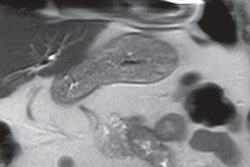SAN FRANCISCO - Nonthoracic MRI scans are safe for patients with cardiac pacemakers or implantable cardioverter defibrillators (ICDs), according to preliminary results from the MagnaSafe Registry presented on March 10 at the 2013 American College of Cardiology (ACC) meeting.
There were no deaths or failures of devices or leads that required immediate replacement during 1,030 exams performed on 1.5-tesla MR equipment at 17 imaging facilities, according to Dr. Robert Russo, PhD, a cardiologist at Scripps Clinic in La Jolla, CA.
What's more, changes to cardiac device parameters were rare. The MagnaSafe study is ongoing, and final results will ultimately reflect the MRI experience of 1,500 patients.
The unremarkable imaging experience for patients who received up to 10 MRI exams suggests that concerns about pacemaker lead heating from MRI are "probably of minimal significance," Russo said.
Difference of opinion
The underlying premise of the MagnaSafe study marks a sharp difference of opinion dividing cardiologists from diagnostic radiologists, who have long recommended against MRI scans for patients with pacemakers and ICDs.
In radiology, cardiovascular implants are considered a relative contraindication for MRI. Potential risks have been associated with the movement or vibration of pulse generators or leads, transient or permanent damage to implanted devices, inappropriate device activation, excessive heating of leads, induced currents, or electromagnetic interference, according to Frank Shellock, PhD, as described at his website MRIsafety.com.
The MagnaSafe group hypothesized that the heart quickly dissipates MR-induced heat through its large circulating blood volume and myocardial perfusion.
"Whatever heating occurs at the lead tip is not only dissipated because the path of least resistance is into the blood pool, but also autoregulation increases vascularity and quickly carries away lots of heat," Russo said.
A need to optimize imaging is also encouraging a fresh examination of the relative risks and benefits of MRI for these patients. Clinical experience suggests that 50% to 70% of the more than 2 million people in the U.S. with implanted pacemakers or ICDs will at some point require MRI, Russo noted. The global installed base of these devices is more than 6 million, and in many instances, no acceptable alternative to MRI is available for brain, spinal, and extremity imaging, he said.
The MagnaSafe study included adult patients who were implanted with a permanent pacemaker or ICD after 2001 and who had been scheduled for nonthoracic MRI based on a strong clinical indication for the procedure. Most procedures involved neuroradiological applications in the brain and spine, or orthopedic conditions in the extremities.
Patients were excluded when they harbored embedded metallic objects, had an ICD and were pacemaker-dependent, used an active implanted device other than a pacemaker or ICD, or were embedded with abandoned leads from previous pacemaker installations. Claustrophobic patients were also excluded.
The U.S. Food and Drug Administration's (FDA) Center for Devices and Radiological Health (CDRH) issued an investigational device exemption for MagnaSafe in April 2009. The registry protocol itself was written in consultation with CDRH and was altered to be limited to nonthoracic scans because of FDA concerns about the risk of intrathoracic MRI applications, Russo told AuntMinnie.com.
In response to a request from the registry's sponsors, the U.S. Centers for Medicare and Medicaid Services (CMS) modified its national coverage determination for MRI in March 2011, granting Medicare coverage for MRI in patients with pacemakers or ICDs when the procedure is performed in a research study.
Positive initial findings
Russo reported no deaths, nor any device failures or lead failures requiring immediate replacement, in the first 1,030 MR procedures recorded by the registry. No loss of capture was observed for 207 scans involving patients who were paced during MR exams.
Five patients experienced an induced atrial fibrillation (AF) during MRI. Of that total, four had a history of AF and were on warfarin and other antiarrhythmia drugs. The fifth patient was pacemaker-dependent and was paced through a lumbar spine MRI. He lacked a history of medication and experienced atrial fibrillation that was resolved 48 hours after imaging, Russo said.
Three patients had partial electrical resets during MR brain scans. A fourth patient experienced a partial reset during a lumbar spine study.
Secondary clinical outcomes included a 0.04 volt or greater decrease in battery voltage in 3% of patients. A pacing load threshold increase of more than 0.5 volts was observed for 1%. P-wave amplitude fell more than 50% in 1% of cases, and R-wave amplitude decreased more than 50% in less than 0.5%.
Pacing lead impedance rose more than 50 ohms in 3% of the exams. A high-voltage impedance change more than 3 ohms was observed in 17%.
The researchers did not expect to see many repeat exams, but the preliminary results revealed that about 19% of patients received more than one MRI procedure. One patient with a brain disorder underwent 10 procedures.
Russo hopes the final results from MagnaSafe will encourage the American Heart Association and ACC to modify recommendations against MRI for pacemaker and ICD patients. Efforts encouraging CMS and FDA to alter their policies are under way.
Russo also plans to reach out to radiologists.
"One of the biggest problems we have is the classical training that has led radiologists to exclude patients from the fear that there would be great risk to patients with implanted cardio devices," he said. "We need get the word out that patients who need scans can probably get through them with very low risk."



.fFmgij6Hin.png?auto=compress%2Cformat&fit=crop&h=100&q=70&w=100)




.fFmgij6Hin.png?auto=compress%2Cformat&fit=crop&h=167&q=70&w=250)











